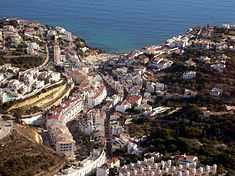Carvoeiro (Lagoa)
| Carvoeiro | ||
| Praia de Carvoeiro | ||
| Civil parish (Freguesia) | ||
 | ||
|
||
| Official name: Freguesia de Carvoeiro | ||
| Country | ||
|---|---|---|
| Region | Algarve | |
| Subregion | Algarve | |
| District | Faro | |
| Municipality | Lagoa | |
| Center | Carvoeiro | |
| - coordinates | 37°06′N 08°28′W / 37.100°N 8.467°W | |
| Lowest point | Sea level | |
| - location | Atlantic Ocean | |
| - elevation | 0 m (0 ft) | |
| Area | 14.12 km2 (5 sq mi) | |
| Population | 2,784 (2011) | |
| LAU | Freguesia/Junta Freguesia | |
| - location | Rua do Barranco , Edifício I/II, Colina Dourada | |
| President Junta | Jorge Manuel Neto Pardal | |
| Timezone | WET (UTC0) | |
| - summer (DST) | WEST (UTC+1) | |
| ISO 3166-2 code | PT- | |
| Postal zone | 8400-508 Carvoeiro | |
| Area code & prefix | (+351) 282 XX XX XX | |
| Patron saint | Nossa Senhora da Encarnação | |
| Parish address | Rua do Barranco, 74; Edifício I/II - Colina Dourada 8400-508 Carvoeiro | |
| Statistics: Instituto Nacional de Estatística[1] | ||
| Website: http://www.carvoeiro.com | ||
| Geographic detail from CAOP (2010)[2] produced by Instituto Geográfico Português (IGP) | ||
Carvoeiro, or more commonly Praia de Carvoeiro, is a Portuguese civil parish in the municipality of Lagoa. Located about 5 kilometres (3.1 mi) south of Lagoa, the parish, covering an area of 14.12 square kilometres (5.45 sq mi) had a population of 2784 inhabitants after the 2001 census (there were approximately 197.2 people per kilometre square).[3]
History

_(3739415383).jpg)
Formed from a picturesque fishing village, with a long history of settlement, the parish slowly developed into a tourist area in the municipality of Lagoa, owing to its the number of sand beaches protected by cliffs. There are vestiges of human settlement, dating to the Roman occupation of the peninsula, as well as early naval activity in the area.[3]
The region was historically unspared from frequent pirate and military assaults along the coast, with a number of naval battles occurring off the coast. Most notably, in 1544, a squadron of ships under D. Pedro da Cunha, battled the Turkish barbary coast pirate, Xarramet.[3] From historical records, the earliest settlement originated in the name Caboiere, an old name for a hamlet of fishermen from the Islamic-medieval period. For most of its history, fishing was the mainstay of the local economy.[3]
However, from the 1960s onward, tourism gradually became the economic base of the area, with many new hotels, apartment complexes, shops, roads, and significant improvements to infrastructures completed to attract visitors to the metropole.[3] An insight into the effects of mass tourism on the Algarve, centred on Carvoeiro was written by Patrick Swift, detailing the community before the arrival of mass tourism by Patrick Swift.[3][4] Swift was an artist and long time resident of Carvoeiro who founded Porches Pottery.
Carvoeiro became a separate/independent parish in 1985 and raised to the status of town on 19 April 2001.[3]
Geography
Algar Seco, a few hundred meters along the coast east of the main square and beach, is a popular nature site where ocean wave erosion has carved out grottoes, islets and water-spouts.
Architecture
To the west of the town is the site of an old ruined fort, ordered built in 1670 as part of the coastal defenses of the Algarve. Only a gate survives. At the same site is the Shrine of Our Lady of the Incarnation, a chapel overlooking the sea, whose construction is said to have antedated the fort.
Civic
- Lighthouse of Alfanzina (Portuguese: Farol da Alfazina), comprising a main rectangular central block, connected by hall and lateral wings (used as residences/living quarters) and central circular tower with spiral staircase, with azulejo tile covering the interior.[5] The design is comparable to the old lighthouse of Capelinhos and Ribeirinha (on the island of Faial in the Azores) or the Lighthouse of Cabo Sardão.[5]
Military
- Fort of Nossa Senhora da Encarnação (Portuguese: Forte do Carvoeiro/Forte de Nossa Senhora da Encarnação), little remains of the fortress, but the eastern wall, where the hermitage of Nossa Senhora da Encarnação and the older buildings of the Fiscal Guard.[6] The fort was constructed in 1670 under the direction of Governor of Algarve, D. Nuno de Mendonça, Count of Val dos Reis, but began to serve as a fiscal outpost after 1870, before becoming a cultural attraction in the middle of the 20th century.[6]
See also

References
- Notes
- ↑ INE, ed. (2010), Censos 2011 - Resultadas Preliminares [2011 Census - Preliminary Results] (in Portuguese), Lisbon, Portugal: Instituto Nacional de Estatística, retrieved 1 January 2012
- ↑ IGP, ed. (2010), Carta Administrativa Oficial de Portugal (in Portuguese), Lisbon, Portugal: Instituto Geográfico Português, retrieved 1 July 2011
- ↑ 3.0 3.1 3.2 3.3 3.4 3.5 3.6 Apresentação (in Portuguese), Lagoa (Algarve), Portugal, 2012, retrieved 6 August 2013
- ↑ Swift, Patrick (1965), Algarve: A Portrait And a Guide, London, England: Barrie & Rockliff
- ↑ 5.0 5.1 Giebels, Daniel (2005), SIPA, ed., Farol da Alfanzina (IPA.00024990/PT050806050024) (in Portuguese), Lisbon, Portugal: SIPA – Sistema de Informação para o Património Arquitectónico, retrieved 6 August 2013
- ↑ 6.0 6.1 Giebels, Daniel (2005), SIPA, ed., Forte do Carvoeiro/Forte de Nossa Senhora da Encarnação (IPA.00011754/PT050806050008) (in Portuguese), Lisbon, Portugal: SIPA – Sistema de Informação para o Património Arquitectónico, retrieved 6 August 2013
